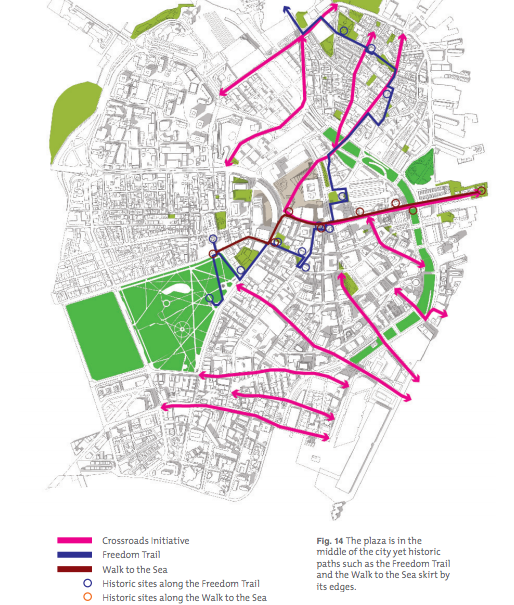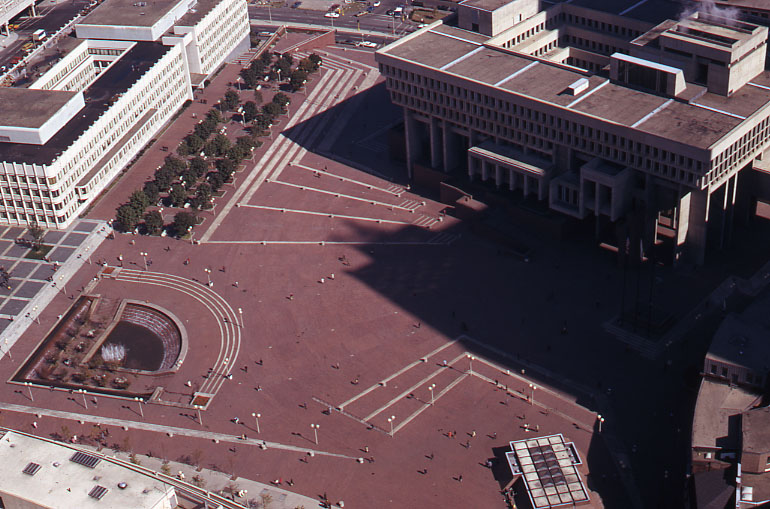
There’s nothing aesthetically pleasing about City Hall Plaza. Granted, there’s a brand new subway station being installed in its midst, and while that bodes well for MBTA ridership and overall user engagement, the lion’s share of the seven-acre area will continue to be perceived as brick badlands. Philadelphia suffered from a similar City Hall ailment and decided to transform that space into a park for everyone to enjoy. Given the fact that our new mayoral administration has a proven commitment to improving open spaces, civic innovation and public art, one has to wonder if it’s conceivable to do the same here in The Hub.
I don’t think we should just throw a park in. Let’s just sit down and have a conversation. But it kind of can be a brick wasteland, that I know.
Though Philly might have had the right idea, and did well to act on those inclinations, Dilworth Park hasn’t been met with rave reviews. Sure the simple fact that it’s no longer a concrete jungle has slightly lifted the spirits of those who frequent that area, but the planning wasn’t enough to impress the likes of architecture critic Inga Saffron, who, according to the Philadelphia Inquirer, said,
They’ve reconstructed the space in front of Philadelphia’s palatial City Hall, furnished it with a cafe, a high-tech spray fountain and movable chairs, and rebranded it Dilworth Park. But the vast granite prairie is still very much a plaza, with all the weaknesses the word implies.
The Inquirer was quick, though, to follow up the printing of Saffron’s quote with others from the Philadelphia public, some of which were overflowing with good words and positive thinking. Whether it’s widely accepted or openly scorned, Dilworth Park is an example by which many other cities can and ought to follow, especially Boston. Because what available space in Boston is more in need of a next-generation facelift, and help adapting to a society where parks are no longer comprised solely of soil and grass but installments to pique the interest of even the most insipid passerby?
Overhauling City Hall Plaza is hardly a novel idea. As recently as 2011, plans were nearly put into play for how to proceed with some kind of redevelopment. In fact, the Boston Redevelopment Authority commissioned design firm Utile, Inc. to devise a master plan for how to proceed with the space within the constraints of a $100,000 budget, per a grant from the Environmental Protection Agency.

Two themes were incorporated in the designs: street connectivity and horticulture. The specs apparently solved the problem of linking the plaza with adjacent roadways, bike lanes and vehicle parking access. They also included various plant life, stormwater management, and, of course, what’s become the $90 million Government Center station project.
The logistical, structural, environmental and aesthetic benefits would be fruitful; the overall value, more than worth it.
Aside from the reconstruction of Government Center, nothing ever came of it.
“We used grant funding several years ago to come up with a plan for redeveloping the plaza,” The BRA’s director of communications Nick Martin told me. “We’ve had conversations with Mayor Walsh’s administration about where the plan stands and if they’d like to do anything differently.”
As it turns out the Mayor Marty Walsh way of doing things is completely different than his predecessor’s way of doing things, no longer wielding the power of the BRA to streamline pet projects and rub elbows with developers but rather employing the organization to function at the behest of Bostonians’ interests. What that means for City Hall Plaza specifically still remains to be seen.
“There’s no immediate vision for what happens next,” Melina Schuler, spokesperson for Mayor Walsh, assured me. “It could be put on the table but it’s open to discussion.”
But Schuler also made it abundantly clear that the old ways of doing things when it comes to the BRA are over, if not evidenced enough by Mayor Walsh’s sweeping and condemning audit of the agency.
“[Development] is thought about a little differently than in the past,” she told me of the BRA and its fleeting master plan.
Despite its desolation, the unofficial epicenter of downtown Boston has become the go-to venue for arts and culture programming with hefty sizes and scopes.
Remember the World Cup watch parties? Or the Donna Summer disco dance party?

The largest event at City Hall plaza is arguably the worst suited for it. Earlier in September, we reported that the popular Boston Calling concert series will continue to be hosted in the shadow of City Hall until 2017. For those who aren’t familiar with the music festival, it runs biannually – once in the spring and once in the fall. Lining up sponsors, selling tickets and booking musical acts has been no problem at all when it comes to Boston Calling. The only real headache has been securing an area large enough to host the festival but comfortable enough for people to actually revel in it.
“A source told BostInno that earlier this year, Boston Calling looked into the field along the Mystic River at Assembly Row, the new development that celebrated its grand opening season this year in Somerville,” wrote my colleague Hilary Milnes
After all, nobody wants to bask in the harmonics of their favorite performers while simultaneously suffering from a sore ass, because bricks range on the exact opposite end of the comfort spectrum from posturepedic.
If we’re talking about installing a park in contemporary Boston, though, grass and floral arrangements are mere iotas of what could be done. There are a number of creative avenues the city could take if it so desired, one of which is already transpiring in the Seaport’s Innovation District.
The Lawn on D is the Boston Convention and Exhibition Center’s 2.7-acre park designed specifically for urban experimentation. Recently outfitted with LED-lit swings and featuring bocce, cornhole, ping pong and other amusing lawn activities, The Lawn on D’s principle purpose is to determine what the park-goers might enjoy, install it, gauge the interest and interaction, and move on to another project.
This empirical approach works advantageously in that it opens up discussion for new designs, improvements and installments while also keeping the park fresh and lively so that people will not tire of it. It also represents a growing trend in urbanism known as ‘playable cities.’ The idea of a ‘smart city’ – one that uses technology and infrastructure to expedite endeavors and processes – has already taken hold in Boston as seen with the announcement of Wicked Free Wi-Fi and open-sourced data.
Playable cities, on the other hand, are based on the idea that a municipal government can garner more residential engagement by creating items for the sole purpose of bringing a smile to one’s face. In the English city of Bristol, for example, officials built a 300-foot waterside in the middle of town, host zombie chase events and close streets just so children can play safely throughout them. City Hall Plaza offers Boston the opportunity to be the catalyst for becoming both a smart and playable city on a grander scale than The Lawn on D.
“I would love it,” newly appointed Chief of Civic Engagement Jerome Smith told me. “But there’s a lot do to. The JFK building owns the far side of the plaza. We should get the feds involved, the state involved, the T, the City, and have a community process. I don’t think we should just throw a park in. Let’s just sit down and have a conversation.”
He admitted in closing though, “But it kind of can be a brick wasteland, that I know.”
Both Schuler and Ryan Woods, the Boston Parks and Recreation Department’s director of external affairs, agree that a community process should be priority number one when it comes to trying to get a park off the ground.

“It is hard to say what is possible for city hall until the MBTA finishes their project at Government Center Station” said Woods. “We would have to have an open public process and get feedback from abutters and local residents. We would also need feedback from structural engineers and landscape architects to see what is possible.” He continued,
Currently, the Plaza is overseen by City of Boston Property Management which has done a great job increasing the programming from concerts, Farmer’s markets, festivals and a successful Donna Summer Roller Dance Party. I think the more positive programming at City Hall Plaza makes it a very welcoming place for both city residents and visitors.
BostInno reached out to City of Boston Property Management for comment, but they referred us back to the BRA.
While public input on this potential project is critical, so too should science be considered. Agnieszka Anna Olszewska published a study titled “Urban Planning, Neurosciences and Contemplation for improving well-being in our cities” in which she observed how participants’ brainwaves differ when shown parks with various features. The settings deemed most contemplative contained the likes of panoramic vistas with views of at least a quarter of a mile, empty spaces, natural asymmetry, clearings and stimulation to look at the sky, all of which, she writes, are “characterized by a high character of peace and silence and biodiversity, and low degree of abstraction and wilderness.”
Features like these are not only good for the people, but for the city as well. The American Planning Association published an economic development study pertaining to urban parks. They determined that parks with aspects similar to what Olszewska deems as contemplative can “enhance property values, increase municipal revenue, bring in homebuyers and workers, and attract retirees,” using Amherst, Mass. as one of its examples.
The fact of the matter is City Hall Plaza is no longer just that. It’s also an attraction and an ugly and inefficient one at that. But Boston possesses the necessary tools, the creative minds and unwavering leadership needed to break ground on a project of this magnitude. Since that limbo period in which Mayor Walsh was elected but had yet to be sworn into office, he’s strived to include as many Boston residents and neighbors in as many planning processes as he can.
He’s also made it his ultimate goal to give Boston a significant role on the international stage, allowing it to flourish innovatively, technologically and economically without losing its medium-size-city feel. An all out South by Southwest-like festival in Boston was just one of the large scale campaign proposals he conveyed to Bostonians upon reaching his City Hall goal.
By charting the proper course, employing the proper personnel and exerting the proper amount of passion, he could make that dream a reality and do it in his own front yard.

